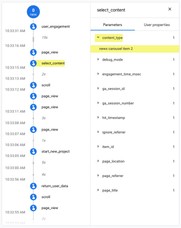If you have a website, and you care about your customers, sales, or marketing tactics, then chances are you have Google Analytics installed. After about 10 years of fairly consistent product direction, Google has recently announced they are retiring their Universal Analytics product and are headed in a new direction with something commonly called GA4—you may be scratching your head wondering what that means.
A Bit of History on Google Analytics
In the beginning … there was Urchin. I mean, not really. The beginning was longer ago than we care to remember and Urchin was just a pit stop along the way. But surely Urchin’s pioneering idea almost two decades ago, “helping companies evaluate the effectiveness of their search engine marketing campaigns by letting them track consumers from when they first enter keywords into a search engine to the actual purchase”, [ source ] deserves a spot in the marketing hall of fame and was instrumental in Google’s decision to acquire Urchin in 2005 and rebrand into the first version of Google Analytics.
ASIDE: If you’ve ever wondered what UTM stands for in those ubiquitous utm_source, utm_medium, and utm_campaign URL parameters, it is Urchin Traffic Monitor [ source ]—which is Urchin analytics’ long-lasting contribution to the fabric of the internet.
Fast forward to 2021 and Google Analytics’ announcement that it was getting a new coat of paint (along with an engine replacement, suspension lift kit, rebuilt transmission, custom wheels, and some exhaust work … you get the picture, it’s a big change). This update is largely courtesy of another acquisition, this time the 2014 acquisition of a company called Firebase. What started as Firebase Analytics and later Google Analytics for Firebase has now been rebranded to Google Analytics 4, commonly known as GA4. But unlike with Urchin, it was an indirect path from the Firebase acquisition to the GA4 product release.
While Urchin was well known and loved by marketers before it became Google Analytics, Firebase was originally known and used mainly by developers—primarily for synchronizing data between iOS, Android, and Web with turnkey support for changes between online and offline connections. Over time, Firebase grew an increasingly diverse set of integrations so that it covered performance monitoring, crash reporting, app notifications, A/B testing, app feature personalization, user-account management and authentication, machine learning, and more.
Firebase Paves the Way for GA4
Continuing their tradition of turnkey solutions, Firebase weaved analytics tightly into these integrations, such that the out-of-the-box product would automatically capture many events and attributes of app users, easily create audiences based on the collected data, help create notification and personalization campaigns based on those audiences, and provide intelligence and measurements of those campaigns’ success—all with minimal programming effort.
From 2014 to 2022, as consumer behavior moved conspicuously away from a computer on a desk to the computer in everyone’s pocket, a divide grew between how people engaged with content and information, and how websites and apps measured and reported on audiences and behaviors. Website analytics focused on page views, sessions, bounces and call-to-action (CTA) clicks while apps focused on engagement, audience types, feedback loops, and a lot of custom events. The web platform has also evolved to become more like apps, supporting functionality such as push notifications and offline capabilities.
By 2019, Google arrived at a crossroads: their analytics products were both successful and catered well to the specific needs and expectations of measurement within their space. But multiplatform customer journeys were falling through the cracks, and anyone tasked with omnichannel reporting would experience pain in harmonizing these different systems’ data. Meanwhile, Google executives were likely questioning the efficiency of separately maintaining two large and heavily-used analytics systems with similar underlying capabilities and purpose. Pushed by market forces to deliver a unified platform for omnichannel analytics, Google chose the platform which grew serving the needs of the modern omnichannel consumer, Firebase, and so began the four-year transition from App and Web analytics to Google Analytics 4 beta and now to a fully-released Google Analytics 4 with official sunsetting of the Universal Analytics product, effective July 1, 2023.
How to Upgrade to Google Analytics 4
When it comes to Google’s tools, there’s undoubtedly going to be a technical and comprehensive support article providing setup guidance. This is the case with Google’s setup instructions for GA4. The problem is there are several options for setting up GA4 and it isn’t clear which path is ideal for your website’s specific data collection needs. In most instances, it helps to consult your web developers or your agency partner for their advice on maximizing your web efforts. Here’s some additional guidance that should help:
- Until mid 2023, you’re able to set up a GA4 property to run alongside your Universal Analytics property. This means you can set up GA4 but may not need to immediately ditch the analytics tool you’re currently comfortable using
- Google provides clear directions for getting set up on most CMS hosted sites (like WordPress, Wix, HubSpot, etc.)
- If you’re currently utilizing a Google Tag Manager account, you should use that to verify your GA4 property
- If you have custom events created in Universal Analytics, these will typically need to be re-created for GA4, except for scroll-tracking, outbound clicks, and video engagement
- These built-in “Enhanced Measurement” events can easily be “switched on”—without requiring custom implementation—from within your GA4 Administration Panel
GA4 vs. Universal Analytics: Know the differences
If you have been using Universal Analytics on your website for a long time, and are trying out GA4 for the first time, then you will likely notice differences not just in how the data is presented, but in the data itself. Many of our customers who have followed best practice advice of installing GA4 alongside Universal Analytics have, quite sensibly, compared the data reported in each and expected to see the same page views, sessions and users in both. In fact, this is frequently not the case.
There are many reasons the data will diverge including a different definition of “User”, different calculations of “Session”, differences in filters, bot detection, and methods of data collection. One major difference is that Universal Analytics requires cookies to track users and sessions whereas GA4 was built with modern privacy expectations in mind, making it more capable of accurate reporting even if visitors to your website have denied use of tracking cookies or have browser settings which frequently purge their cookie data.
Sessions Data Collection Differences Between Universal Analytics and GA4
While both Universal Analytics and GA4 use a 30-minute session by default, there are differences between when they consider a session to be initiated or reset. In Universal Analytics (UA), if a user picks new campaign parameters while on the website, or if their session starts before midnight and ends after midnight (based on the time zone settings of the view), then a new session is created. In GA4, neither of those are true. Universal Analytics also does not increment sessions in cases where a session only consists of non-interaction events.
In contrast, GA4 does not have a non-interaction event type, meaning it counts a new session for any event after the current session has timed out. This includes user engagement, a new concept introduced with GA4: if a website visitor has a browser running in the background and then returns to it an hour later and closes it, GA4 will automatically initiate a new user engagement event and a session to go along with it.
With UA, this re-engagement could be completely missed unless you had scroll-tracking set up and the visitor scrolled enough to trigger that scroll event. GA4 also includes privacy controls such as cookie-less measurement and introduces a new statistical estimate process for counting sessions with high accuracy and low error rate.
GA4 Includes New Metrics But Removes Others
You’ll notice some new metrics in your GA4 reports including engaged session, average engagement time per session, and engagement rate. Most notably, it’s nice to know which of your sessions actually engaged with your website (Google defines an engaged session as a session that lasted longer than 10 seconds, or had a conversion event, or had two or more screen or page views.) On the other hand, GA4 will not report average session duration, pages/session, or bounce rate (metrics you see in Universal Analytics). Note that because engagement has a time threshold associated with it, it cannot be considered the inverse of bounce rate.
Page View Data Should Be Fairly Consistent
One area where GA4 should be consistent with Universal Analytics is page views. According to Google, page views between UA and GA4 should fall, “generally within a few percentage points”. However, be aware that differences in filtering options as well as differences in spam and bot traffic identification could result in larger differences in this measurement. In theory, it is also possible that some browser plugins, security software or ad-blockers could potentially block UA without blocking GA4.
UA and GA4 Event Dimension Differences
In Universal Analytics, events were defined as “a specific hit type with a predefined set of dimensions called Event Category, Event Label, and Event Action (plus the infrequently used Event Value)”. In practice, UA events frequently felt both too complicated and too limiting. With GA4, the event is the basic primitive on which all measurement takes place. For example, a session is started by a “session_start” event and a page view is tracked by a “page_view” or “screen_view” event.
Events have “event parameters” such as page_title, page_referrer, and screen_resolution. The aforementioned event parameters are included by default with every event, but specific events also have specific parameters that more meaningfully describe the event than the basic “category, label, action” schema allowed. For example, the “file_download” event includes file_extension, file_name, link_url, link_text, link_id, link_classes, and link_domain as parameters.
This event parameter schema provides flexibility for creating your own custom events. However, be aware that Google requires you to configure each parameter to report on within your GA4 account and limits a maximum of 50 event-scoped dimensions available for reporting. If you reach your quota and need to create new custom dimensions, you can archive ones you’re no longer using.
Notice how GA4 shows a stream of events and all the event parameters associated with the currently selected event.
Google provides a list of recommended event definitions covering many business cases including search, sign up, login, sharing, ad impressions, e-commerce, games, and tutorials. Google recommends sending these pre-defined events with their prescribed parameters wherever they fit your use-case to benefit from future features and integrations. In some cases, such as the e-commerce purchases report, you must use Google’s required parameters for each e-commerce event. You can send additional custom parameters with e-commerce events but will need to create custom explorations reports or BigQuery reports to view those.
Advantages of GA4
There are several advantages by switching to GA4 reporting including:
- GA4 has enhanced measurement features built-in such as page views, scrolls, outbound clicks, video engagement, file downloads and more (no need to set up custom event tracking to report these metrics)
- GA4 can identify users that visit from different devices and de-duplicate interactions
- GA4 includes some default enhanced e-commerce and user engagement metrics
- GA4 is not reliant on cookies or unique identifiers, prepping you for more stringent data collection legislation in the future
- GA4 can pull multiple data streams (such as an app and a website) into one analytics property
- GA4 can receive offline events up to 72 hours after the event occurred and backfill the data into the correct date/time slot
- GA4 is more efficient/performant on your website, batching multiple events together into a single network transmission
- GA4 audiences let you segment your users by event, action, user property (e.g., age, gender, language or any custom user property captured by your website)
- You can combine events, parameters and properties to include practically any subset of users
- Google automatically enriches your data through machine learning to predict the future behavior of your users (with predictive metrics, you can identify likely purchasers and with predictive audiences, you can segment out your likely purchasers and then share that audience to Google Ads for remarketing)
- Google has made it possible to link your GA4 data with their Data Warehouse product, BigQuery, for the ultimate power and flexibility in merging, filtering, manipulating, and reporting on your data
Should You Upgrade to GA4?
Because Google is sunsetting Universal Analytics, you don’t have much of a choice. You need to set up a Google Analytics 4 property if you want to continue utilizing Google’s free tool for website data and analytics. The transition might take some adjustment because of the differences, but the advantages it brings will help you make informed decisions for your business going forward. Reach out to us at Element if you need help with the switch or want to better understand your website metrics and how to make the most of capturing and reporting on customer, marketing and sales data.










